

Journal of Okayama Medical Association
Published by Okayama Medical Association<Availability>
Full-text articles are available 3 years after publication.
Permalink : https://ousar.lib.okayama-u.ac.jp/18437
大腿骨(骨幹部)栄養動脈及び栄養孔について
加藤 宣博
岡山大学医学部第2解剖学教室
発行日
1962-12-30
抄録
The nutrient arteries to the shaft of the femur are dissected up to the nutrient foramina in 116 limbs of Japanese cadavers from our dissecting room. Results obtained are as follows: 1. The nutrient arteries are two in number in 56.1% of the cases (Tables 1 and 2). 2. The nutrient foramina are situated generally in the upper third (64.9%) of the shaft of the femur, less frequently in the middle third, rarely in the lower third (Table 3). Dividing the shaft in sections A, B and C as illustrated in Fig. 1, in the case of a single artery, it generally enters a foramen in B, with two arteries they enter most frequently foramina in A and B, and with three arteries mostly in A, B and C (Table 7). Thus, the height of the upper-most, second and third foramen varies widely according to the number of the nutrient arteries (Table 8). 3. The position of the nutrient foramina in relation to the linea aspera is presented in Table 9. 4. The origin of the nutrient arteries (Tables 10-14). The nutrient arteries arise generally from the perforating arteries (Table 11). Arteries that enter the foramina in A originate most frequently from the Ist perforating artery or the Ⅱnd perforating artery branched out from the Ⅰst perforating (a in Fig. 2 and Tables 12 and 13), less frequently from the intrinsic Ⅱnd perforating (c). Arteries to the foramina in B arise most frequently from the intrinsic Ⅱnd perforating, less frequently from the Ⅲrd perforating (e). Arteries to the foramina in C arise generally from the Ⅲrd perforating (Tables 10 and 13). 5. Conclusion: According to the origin of the arteries and the height of the foramina, the nutrient arteries to the shaft of the femur are distinguished into proximal, middle and distal groups. In the most typical pattern, the proximal nutrient artery arises from the Ⅰst perforating and enters the foramen in A (Fig. 1), the middle nutrient arises from the Ⅱnd perforating and enters the foramen in B, and the distal nutrient arises from the Ⅲrd perforating and enters the foramen in C. Generally there occur two of these nutrient arteries, less frequently a single artery (especially the middle perforating) and sometimes all of the three (Tables 7 and 14). Though rarely, one of them occurs in double, by which various patterns give rise.
ISSN
0030-1558
NCID
AN00032489
